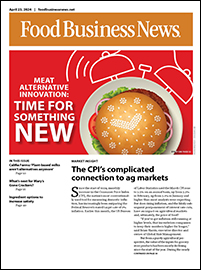VEVEY, SWITZERLAND — Underperformance in frozen food and coffee creamer capacity constraints weighed on Nestle SA’s performance in North America during 2024.
“… In North America, our growth was disappointing,” said Anna Manz, chief financial officer, during a Feb. 13 conference call to discuss full-year results. “Consumer demand was weak, particularly at the lower end of the income spectrum. We lost share in frozen food, and we were held back in coffee creamers by capacity constraints for most of the year. Our actions to improve competitiveness in these underperforming cells have not yet translated to a meaningfully improved growth trajectory.”
Laurent Freixe, president and chief executive officer, said price gaps with a “major competitor” contributed to the frozen food underperformance.
“We have now lowered prices as well as launched new products,” he said. “We have begun to see evidence of success and have some early gains in volume share. Overall, we are still early in addressing many of our issues, but we are moving and there are some encouraging signs.”
Zone North America sales for the year ended Dec. 31 were 25.3 billion Swiss francs ($28 billion), down 2.5% when compared with 2023 when the business unit had sales of 26 billion Swiss francs ($29 billion).
While the Zone’s performance was weighed down by frozen food and coffee creamers, there were some bright spots. In confectionery, for example, the business grew at a double-digit pace driven by Toll House baking products and pricing actions, according to the company. Pet care also was a bright spot, especially in premium brands for cats and products intended for therapeutic diets.
During the company’s investor day this past November, Manz said it would take time for the company’s new strategy to be fully realized, perhaps as long as 18 to 24 months. At the same time, the company committed to generating 2.5 billion Swiss francs ($2.8 billion) in cost savings by the end of 2027 that would be used as fuel to generate the company’s return to growth. During the call management outlined the progress being made in cost savings.
“To date, over 300 million Swiss francs of the expected savings for 2025 have already been secured,” Freixe said. “To bring these saving opportunities to life, I want to give you a few examples, starting with procurement.
“With annual spend of over 60 billion Swiss francs, we see lots of opportunities in this area. We are increasing the consolidation of our spend and we are doing it in a more systematic way. One example of this is we are currently moving from a centralized ingredient catalog covering 50% of raw material spend to 80% of coverage.
“In addition, we are leveraging AI (artificial intelligence) tools to review invoices versus our contracts to identify and recover value leakage. In the last three months we have assessed approximately 3,000 of our largest suppliers, covering over 80% of our total spend. This has allowed us to identify historical inconsistencies between contract and invoice that can be recovered, providing a one-time benefit.”
He added that in manufacturing and logistics that digitalization is unlocking efficiencies in areas like plant maintenance and energy usage.
“We are also looking at our operating model with an end-to-end view across our functions,” he said. “This includes spans and layers, central versus local, shared service centers, and automation. For example, our in-market finance teams spend, today, 40% of the time on data compilation, report updates, and ad-hoc analysis. With today's technology, it should be less than 5%.”
For 2024, Nestle’s company-wide sales were 91.4 billion Swiss francs, down 1.8% from 2023 when the company generated sales of 93 billion Swiss francs. Pricing and organic growth had a 1.5% and 2.2% impact respectively while foreign exchange had a negative 3.7% impact.



